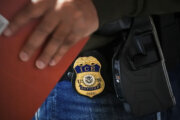Catholic schools’ efforts to welcome students back to classrooms exemplify the challenges many D.C.-area districts have faced: balancing reopening schools with teacher and student safety.
The schools in the Diocese of Arlington, which include 37 parish schools, four high schools, three preschools and five independent Catholic schools in 12 different jurisdictions, have had some in-person learning since the start of the 2020 school year.
“In those 37 parish schools, two-thirds of them are back full-time,” said Dr. Joseph Vorbach, superintendent of schools for the Catholic Diocese of Arlington.
All of the diocese’s high schools have been using hybrid learning since the start of the school year, and the hybrid models might vary among the elementary schools, with some schools putting younger children in classrooms more than older children, and one parish school using a morning-afternoon model for its students.
Vorbach, commenting on the most recently-available data from January, said that there has been “basically no community spread” in the schools, and he said the mitigation strategies in place have been strong.
But he concedes that diocese schools don’t have the challenge of school buses that public schools face, which presents a separate platform requiring social distancing.
“There have been, out of 16,800 students, only 174 instances of a student having tested positive for COVID,” Vorbach said.
Some students have had to quarantine to deter further spread of COVID-19. Vorbach said in some cases, it was a few students, a classroom, a full grade, and in a few cases, some entire schools temporarily shifted to a period of remote learning from in-person learning.
Vorbach said principals, teachers and staff have been vigilant during the pandemic and have been quick to adapt to changing circumstances.
“(We’ve had) teachers making significant adjustments, being ready to shift at a moment’s notice between in-person learning and e-learning,” Vorbach said.
Like some public schools in the area, such as in D.C., Vorbach said that each school leader developed a reopening plan suitable for the community, taking into account geography, facilities and population density. Diocese schools communicated with local public health officials and implemented customary mitigation strategies in school buildings.
One thing school leaders did was look for ways to use all available building space to spread out classrooms.
“How could you repurpose parts of the building that may not otherwise have been used for instruction? Could you set that up for instruction to facilitate more spacing and to keep more kids in the building? … We’ve seen gymnasiums and cafeterias and other common spaces repurposed that way,” Vorbach said. Also important to having students back in classroom, according to Vorbach, has been principals who share information with each other.
“The largest number of our schools are in Fairfax County, so there’s been a lot of cross-talking among our school principals and working closely with public health officials,” he said.
Throughout the country, enrollment in public schools has dropped, as parents seek out private schools, home schooling and other ways to deliver education during the coronavirus pandemic.
- Sign up for WTOP alerts
- Latest coronavirus test results in DC, Maryland and Virginia
- Coronavirus vaccine FAQ: What you need to know
- Latest vaccination numbers in DC, Maryland and Virginia
- Some seniors frustrated with new Md. vaccine appointment call center
- Prince George’s Co. to release plan for classroom return
- Homeowners, renters in Md. struggling with payments during pandemic
Looking for more information? D.C., Maryland and Virginia are each releasing more data every day. Visit their official sites here: Virginia | Maryland | D.C.








